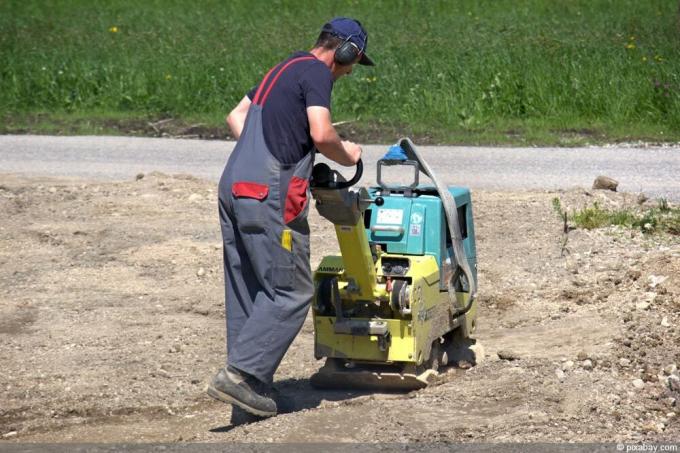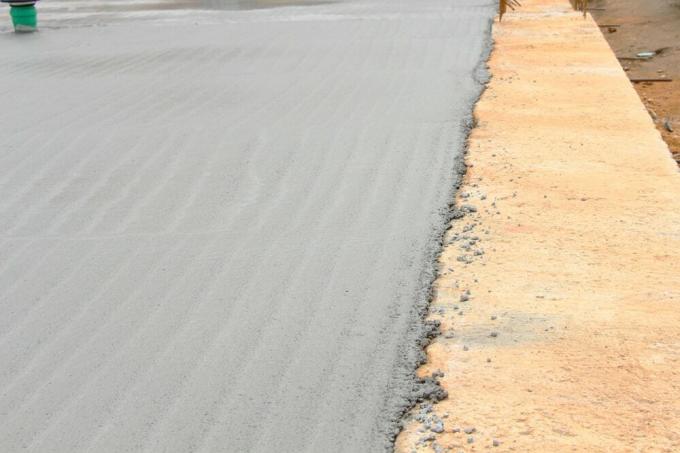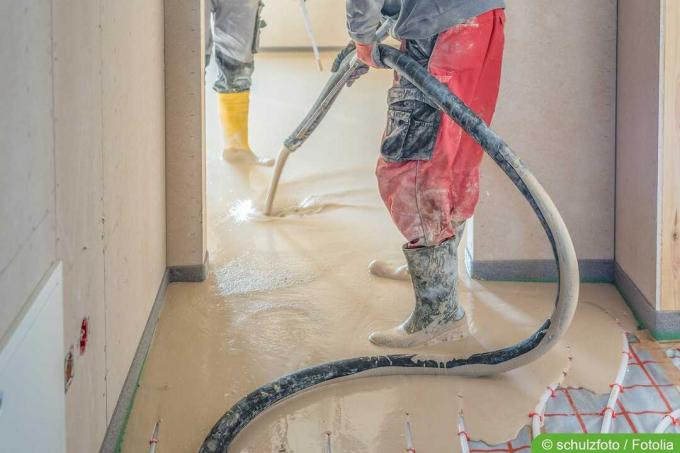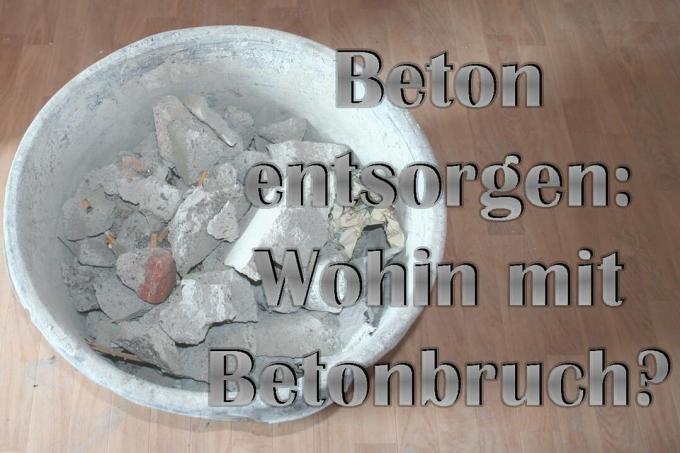

Table of contents
- Properties of mineral concrete
- grit
- composition
- Processing mineral concrete
- Use in the private sector
Mineral concrete is a special form of conventional concrete, as it does not contain cement as a binder. It is a mixture of rock grains of different sizes. The proportion of broken grain is usually very high. Only water is required to mix the processable base material. It is important that the mineral concrete is properly compacted after spreading. In this way, load-bearing layers or substructures for paths, streets and other areas can be created. So far, mineral concrete has been used less frequently in the private sector.
Properties of mineral concrete
After mixing, the mineral concrete is a highly compacted building material made from various types of gravel, grit or crushed gravel. It is a material with high strength, which is mainly used for large-scale construction work in gardening or landscaping. One of the advantages of mineral concrete is its high frost resistance and its high stability, provided the building material has been processed correctly. Flat surfaces can be produced without any problems, which can be loaded immediately after processing and completion. If damage occurs to the surfaces, they can be easily repaired. Depending on the grain size, the building material may or may not be permeable to water.
grit
The costs for the mineral concrete depend, among other things, on the respective grain size. It is indicated by a number composed of the sizes for the smallest and the largest grains. A grain size of 2/45 means that the smallest grain size is 2 millimeters, while the size of the largest grains is 45 millimeters. This value essentially determines the properties of the mineral concrete after mixing. There are also types of concrete with so-called zero fractions of small grain sizes such as 0/45. After processing and compacting, these materials become completely waterproof.
The zero grain and what it is all about
In the case of a granulation with proportions of smaller granules, tiny spaces remain between the granules after processing and compaction, through which the water can drain. However, water-impermeable base layers made of mineral concrete should only be used if the subsequently applied top layer is also water-impermeable.
The size of each grain
The size of the largest grains and their proportion in the concrete are also very important. If the grain sizes used are too large, it becomes more and more difficult to produce the concrete cover and, above all, to compact it. Very powerful vibratory plates are required for the processing of such materials.
composition

Only the smallest and the largest grain size can be seen at first glance. However, the exact composition of the building material is at least as important as the grain size. There are numerous sizes for the smallest and largest grains. In addition, their proportions can differ greatly in the different types of concrete. There are so-called grading curve diagrams in which the shares are shown as percentages. With the help of these diagrams it is possible to identify the exact structures of the respective mixtures. The so-called ideal grading curve, which is often also referred to as the Fuller parabola, is important in this context. It characterizes the ideal distribution of the different grain sizes and their sizes in a specific concrete mix. If this ideal grading curve is reached, the cavities between the individual grains are approximately the same size. The particle size distribution is ideal in this case.
Processing mineral concrete
It is a popular building material, but it has to be processed professionally. In order to proceed as professionally as possible, the correct grain size should first be selected. The delivery takes place directly from the concrete plant or gravel plant, usually already mixed, so that work can begin immediately. If the material is mixed yourself, the mixing ratio should be observed as precisely as possible. It is also very important to mix the building material very well before processing and then to process it as quickly as possible. The processing itself takes place in a few steps:
- mix the concrete (observe the mixing ratio exactly)
- then spread the concrete mixture evenly
- compact with the vibrating plate
- If necessary, repeat the process with additional layers of concrete
- Apply top coat
What should be considered during processing
When spreading, it is important that the area in question is brought to the correct height, taking into account the additional top layer. Also very important for determining the thickness of the concrete layer is the amount of the planned load on the corresponding area. The higher the load, the stronger the base layer must be. If it is an area that cannot be driven on, the thickness can be between 20 and 30 centimetres, for example. If the area is driven on, the thickness of the concrete layer should be at least 40 centimetres, and it can be a little more if heavy equipment is driven on.
Working with multiple layers of concrete
If the concrete layer is applied with a thickness of more than 40 centimetres, this should be done in layers. For example, 20 centimeters can be applied as the first layer. Further material is then applied and compacted. By processing, compacting and producing the concrete layer in layers, its stability increases significantly.
Compaction with the vibrating plate

The compaction itself is done with a vibrating plate. If the concrete has a coarser grain size, the vibrating plate must be powerful enough to ensure adequate compaction. The size of the largest grain is decisive. When compacting with the vibratory plate, special protective measures should be taken. It is a loud and powerful work tool. Safety gloves, safety shoes and hearing protection are therefore mandatory.
Use in the private sector
Normally, mineral concrete is mainly used for larger areas. In the private sector, this is rarely the case. The building material can be used, for example, to create a foundation for a garden shed or to provide a base material for somewhat longer distances, in order to then apply a top layer to bring up. Alternatives such as gravel can be used to work on smaller areas, which in this case are usually associated with less effort and costs.
Price for mineral concrete with different grain sizes
The price of the building material depends on various factors. One of the most important cost factors is the grit. There are sometimes quite large differences between individual offers. The differences can be regional, for example. There are other differences in prices between the regional specialist trade and well-known ones Providers of the building materials and the prices that are researched in a price comparison on the Internet can. In addition, the purchase quantity often plays an important role. A comparison is definitely worthwhile. Here are some price examples from price comparisons on the Internet for different grits:
- Mineral concrete with a grain size of 0/11, 0/16, 0/22 or 0/32 at prices between around 16.00 and 17.00 euros per ton (water-impermeable mineral concrete because of the so-called zero grain sizes, i.e. no shares of small grains)
- Mineral concrete with grain sizes of 0/45 at prices between around EUR 20.00 and 22.00 per ton (also zero grain sizes for the production of water-impermeable concrete layers)
- Grain sizes of 16/22 or 22/32 (grit, water-permeable) at prices between EUR 19.00 and 20.00 per ton

However, the prices can vary greatly. The price for the respective delivery quantity and of course the delivery costs should also be taken into account with smaller quantities can be relatively high if the concrete is delivered separately by truck must. Usually this is only worthwhile from a certain delivery quantity. However, this type of concrete should only be used for larger areas anyway, so that the costs are in proportion to the effort involved.
Also important is the financial expense that has to be factored in when renting a suitable vibrating plate. Processing and compaction are virtually impossible without this tool.
Determination of the required quantity
It is not at all easy to determine the actual need for mineral concrete for the area to be processed. In most cases, there is nothing left but to estimate as accurately as possible. The concrete layer can be calculated by multiplying the length and width of the base layer together and by the desired height. This will give you the volume in cubic meters that needs to be refilled. However, there is a problem: the building materials can also be ordered in cubic meters. However, this information always refers to the so-called bulk material, i.e. the quantity that is delivered before the actual compaction. However, the finished mineral concrete bed is at least double or even triple compacted. Accordingly, more material is required.
Best to ask the dealer
The actual amount can therefore only be estimated approximately, since the actual compaction and the consequent reduction in the total volume cannot be predicted exactly. It depends on the grain size and changes depending on the respective rock mixture. However, you can ask the retailer what volume is estimated to be required for which volume. They can usually tell you that with relative accuracy.
 Home editorial office
Home editorial office
Learn more about concrete, screed and cement

Fresh screed: when can it be walked on?
Screed is the basis for many floor coverings. It is durable and easy to care for. However, if the load is applied too quickly after application, it can be damaged, with costly consequences. We show how long the drying time is.

What is fiber concrete? | Features & Best Practices
What is fiber concrete? This term describes special concretes that are mixed with different fibers. They expand the possible uses in many ways and have an effective effect on the stability and durability of the concrete.

What is trass cement? | The differences to cement
Trass cement describes a special type of cement with corresponding amounts of trass. The additive makes the mortar mixed from it more resistant and is effectively suitable for certain areas of application. In this guide you will find out how the mixture differs from conventional cement mixtures.

What is flow concrete | Properties & Applications
As the name suggests, flowable concrete is a much more fluid mass than conventional concrete. This is made possible by adding a flow agent. You can find out about the properties and areas of application of concrete in this guide.

How much does a cubic meter of concrete cost? | precast concrete prices
The independent production of concrete is done in a few simple steps thanks to ready-mixes from the hardware store. The so-called ready-mixed concrete consists of various components and is available in different variants depending on the intended use. The price per cubic meter depends on several factors.

Disposing of concrete: what to do with broken concrete?
Broken concrete often occurs during conversion or demolition work. It is clear that the chunks do not belong in the normal household waste. However, this raises the question of whether concrete is building rubble, construction waste or even hazardous waste.
